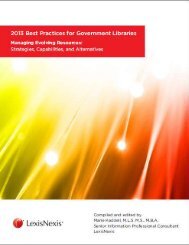2012 Best Practices for Government Libraries
2012 Best Practices for Government Libraries
2012 Best Practices for Government Libraries
Create successful ePaper yourself
Turn your PDF publications into a flip-book with our unique Google optimized e-Paper software.
236<br />
BEST PRACTICES <strong>2012</strong><br />
Another possible way to enhance the value of the catalogue is to enable to<br />
search <strong>for</strong> content within specific departmental materials, <strong>for</strong> example searching the<br />
contents of the department's annual reports. Usually a department will have<br />
digitally born annual reports and hard-copies that have not been digitised. To find<br />
in<strong>for</strong>mation within the annual reports they each must be searched individually. One<br />
solution is to add an extra full-text searchable field to the catalogue record<br />
structure. Then OCR digitize the hard-copy annual reports. Catalogue each of the<br />
annual reports separately and import the content of each document into the<br />
respective full-text field. A search page can be designed <strong>for</strong> just searching the fulltext<br />
contents of the Department's annual reports. See Figure 1.<br />
Figure 1. Example of a separate search page <strong>for</strong> searching full-text records in a<br />
library catalogue<br />
Keep in mind, whatever changes you make to your catalogue, maintain a<br />
record, such as a procedures manual. You may leave your job and the next person<br />
will need to be able to identify the non-standard fields you have created and how<br />
they are used to ensure that the added value is not lost. Also, this would help<br />
mapping fields if a new library catalogue system is introduced (whether an upgrade<br />
or through amalgamation).<br />
The whole concept of collection development is changing. Many solos now have<br />
to decide to catalogue or not to catalogue, to import or not import (within<br />
copyright) digitally born non-commercial materials produced by external<br />
organisations that are relevant to their department. You need to assess the risk of<br />
the importance of not having the material at all. The risk of material disappearing is<br />
not a variation of the “just-in-time” or “just-in-case” argument regarding collection<br />
development.<br />
While on the subject of cataloguing, cataloguing rules are changing with the<br />
most significant change being the introduction of RDA. RDA is being adopted as the<br />
cataloguing standard by major libraries. To keep oneself abreast of the changes<br />
subscribe to a cataloguing discussion lists or LinkedIn Group. One such list is ACAT<br />
(AutocatListserve) (https://listserv.syr.edu/scripts/wa.exe?A0=AUTOCAT) and the<br />
discussions on cataloguing are very illuminating.<br />
For enhancing library services including the catalogue and other services,<br />
Code4Lib (http://www.code4lib.org/) is a good list to follow. You will find<br />
discussions on new services, issues, and problems that might arise in<br />
implementation to new services, alternative software available and/or work-arounds



